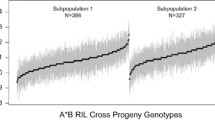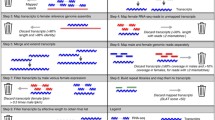Abstract
The effect of the Y-chromosome on the sexcombs in the legs ofDrosophila melanogaster has been examined in four different genotypes, viz., Oregon R+,y, sx andPc-Scx. For this purpose, various Y-chromosome-fragments (YL and YS) and one or two XO conditions have been used.
The results of this investigation show that both long (YL) and short (YS) arms of the Y-chromosome tend to increase the teeth number in the sexcomb of the first legs in all genotypes excepty. The XO-1 condition, derived by the loss of one X, appears to decrease it; the XO-2, resulting from the fertilization of an X-bearing ovum by a nullo-Y sperm, appears to show an increased teeth number or no effect at all. The effect of Y-fragments is least in the case ofy and maximum insx. The various Y-fragments used also show a parallel, though inversely related, effect on the production of intermediate bristles insx.
These Y-fragments show an opposite effect on the sexcombs of the second and third legs of thePc-Scx genotype. Here the mean numbers of teeth are significantly reduced in all cases as compared to those in XY;Pc-Scx/++ genotype.
The different Y-fragments behave differently in their effect on sexcomb pattern. It has been suggested that secondary modifiers may be present in association with different genotypes as well as in the Y, which are required to maintain a morphodynamic equilibrium in pattern formation.
Similar content being viewed by others
References
Baker, W. K. &J. B. Spofford (1959). Heterochromatic control of position effect variegation inDrosophila.The Univ. of Texas Publ. No. 5914: 135–154.
Bridges, C. B. & K. S. Brehme (1944). The mutants ofDrosophila melanogaster. Carnegie Instn. of Wash. Publ. 552.
Brown, E. H., &R. C. King (1961). Studies on the expression of the transformer gene ofDrosophila melanogaster.Genetics 46: 143–156.
Combs, J. D. (1937). Genetic and environmental factors affecting the development of the sexcombs ofDrosophila melanogaster.Genetics 22: 427–433.
Dronamraju, K. R. (1965). The function of the Y-chromosome in man, animals and plants.Adv. in Genetics 13: 227–310.
Goldschmidt, R. B., A. M. Hannah &L. K. Piternick (1951). The podoptera effect inDrosophila melanogaster.Univ. Calif. Publ. Zool. 55: 67–294.
Gottlieb, F. J. (1963). A method for mountingDrosophila body parts.D.I.S. 37: 140.
Hannah-Alava, A. (1958a). Morphology and chaetotaxy of the legs ofDrosophila melanogaster.J. Morph. 103: 281–310.
Hannah-Alava, A. (1958b). Developmental genetics of the posterior legs inDrosophila melanogaster.Genetics 43: 878–905.
Hannah-Alava, A. (1964). Interaction of non-allelic loci in expression of the extrasexcomb phenotype inDrosophila melanogaster.Z. Vererb. lehre 96: 1–9.
Hannah-Alava, A. &C. Stern. (1957). The sexcombs in males and intersexes ofDrosophila melanogaster.J. Exptl. Zool. 134: 533–556.
Hess, O. (1964). Struktur-Differenzierungen im Y-Chromosom vonDrosophila hydei und ihre Beziehungen zu Gen-Aktivitäten. I. Mutanten der Funktionsstrukturen.Verh. Deutschen Zool. Ges. 28: 156–163.
Hildreth, P. E. (1965). Doublesex, a recessive gene that transforms both males and females ofDrosophila into intersexes.Genetics 51: 659–678.
House, V. L. (1953a). The interaction of mutants affecting venation inDrosophila melanogaster. I. Interaction of Hairless, engrailed and cubitus inter ruptus.Genetics 38: 199–215.
House, V. L. (1953b). The interaction of mutants affecting venation inDrosophila melanogaster. II. Additive and pattern effects of combinations of Hairless, engrailed and cubitus interruptus.Genetics 38: 309–327.
Mather, K. (1941). Variation and selection of polygenic characters.J. Genetics 41: 159–193.
Mather, K. (1944). The genetical activity of heterochromatin.Proc. Roy. Soc. Lond., B,132: 308–332.
Mukherjee, A. S. (1964).Developmental genetics of the mutant “sexcombless” in Drosophila melanogaster. Ph. D. Thesis, Univ. of California, Berkeley.
Mukherjee, A. S. (1965). The effects of sexcombless on the forelegs ofDrosophila melanogaster.Genetics 51: 285–304.
Mukherjee, A. S. & Nivedita Mitra (1967). Effect of the mutant sexcombless on the posterior legs ofDrosophila melanogaster. Indian J. Cytol. Genet. (In Press).
Mukherjee, A. S. &C. Stern (1965). The effect of sexcombless in genetic mosaics ofDrosophila melanogaster.Z. Vererbungsl. 96: 36–48.
Stern, C. (1954). Two or three bristles.American Scientist 42: 213–247.
Stern, C. (1956). The genetic control of development competence and morphogenetic tissue interactions in genetic mosaics.Roux' Archiv für Entw. mechanik 149: 1–25.
Stern, C. (1965). Developmental genetics, in “Genetics Today” ed. S. J. Geerts,Proc. 11th Intern Congr. Genetics, The Hague 2: 221–226.
Stern, C. &A. S. Mukherjee, (1964). Aspects of developmental genetics of legs ofDrosophila.Proc. Natl. Acad. Sci., India 34: 19–26.
Stern, C. &C. Tokunaga (1967). Nonautonomy in differentiation of patterndetermining genes inDrosophila. I. The sexcomb of eyeless-dominant.Proc. Natl. Acad. Sci. 57: 658–664.
Tokunaga, C. (1961). The differentiation of a secondary sexcomb under the influence of the gene engrailed inDrosophila melanogaster.Genetics 46: 157–176.
Tokunaga, C. (1963). Gene action ofesc (extra sexcomb) inDrosophila melanogaster. (Abstract). “Genetics Today”, ed. S. J. Geerts,Proc. 11th Intern. Congr. Genetics, The Hague 1: 170–171.
Tokunaga, C. &C. Stern (1965). The developmental autonomy of extra sexcombs inDrosophila melanogaster.Develop. Biol. 11: 50–81.
Author information
Authors and Affiliations
Additional information
This investigation has been supported by a grant from Council of Scientific and Industrial Research to the first author, Scheme No. 38 (77)/65-GAU-II.
Rights and permissions
About this article
Cite this article
Mukherjee, A.S., Datta, R.K. & Mitra, N. Genetic control of morphogenetic variation in the sexcombs of drosophila melanogaster. Genetica 38, 340–354 (1967). https://doi.org/10.1007/BF01507466
Received:
Issue Date:
DOI: https://doi.org/10.1007/BF01507466




